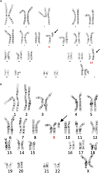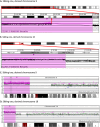Phenotypic and genotypic insights into concurrent tertiary trisomy for 9p and 18p
- PMID: 39924478
- PMCID: PMC11808968
- DOI: 10.1186/s13039-025-00704-9
Phenotypic and genotypic insights into concurrent tertiary trisomy for 9p and 18p
Abstract
Background: Carriers of balanced reciprocal translocation are usually phenotypically normal; however, they have an increased risk of producing gametes with chromosomal imbalance through different types of meiotic segregation of the translocation quadrivalent. The genetically imbalanced gametes when they survive can result in embryos with chromosomal abnormalities. Here we report a family with two siblings inheriting partial trisomy for 9p and 18p concurrently resulting from a 3:1 meiotic segregation of a maternal balanced translocation involving chromosome 9q and 18p, and the associated phenotype.
The family - case presentation: The family was ascertained because of severe congenital anomalies in a newborn male (sibling 1). The karyotype of this patient was 47,XY,+del(9)(q13q34). Cytogenetic analysis revealed that the phenotypically normal mother harbored a balanced translocation 46,XX,t(9;18)(q13;p11.21). Chromosomal microarray analysis (CMA) of the abnormal child detected segmental trisomy for 9p and 18p. In conjunction with conventional cytogenetic results of the mother and CMA results of the affected child, the final karyotype of sibling one was 47,XY,+der(9)t(9;18) (q13;p11.22)dmat. arr[GRCh36] 9p24.3q13(199254_70163189)× 3, 18p11.32p11.22(131491_9640590)× 3; this resulted in segmental duplication of 69.96 Mb on 9pter->q13 and 9.51 Mb on 18p. There was a subsequent birth of a female sibling (sibling two) with multiple anomalies, including dysmorphic facial features, kidney aberration, cardiac defects, and abnormal brain MRI. The G-banded karyotype of this sibling was 47,XX,+del(9)(q13q34). The final karyotype of this sibling after CMA results was 47,XX,+der(9)t(9;18)(q13;p11.22)dmat. arr[GRCh37] 9p24.3p13.1(209020_38763958)× 3; 18p11.32p11.22(146484_9640912)× 3. The apparent discrepancy between the array results of the two siblings is attributed to difference in the design of array chips and genome builds used for these patients (NimbleGen/Roche v2.0 3-plex and GRCh36 for sibling one, and GGXChip + SNP array and GRCh37 of Agilent Technologies for sibling two). There are 182 OMIM genes in the duplicated region of 9p and 33 OMIM genes in the duplicated region of 18p which may have contributed to the clinical features of the affected siblings.
Conclusions: To our knowledge, we report the first two cases of concurrent partial trisomy 9p and 18p in the same family. This report adds more information about phenotypic effects of these chromosomal copy number gains and supports chromosomal microarray analysis as the standard for precise identification or demarking regions of duplications, particularly when the translocation involves at least one subterminal segment. In view of the recurring infants with congenital anomalies the couple may benefit from prenatal chromosome analysis of future pregnancies or opting to assisted reproductive methods and transferring normal embryos for implantation.
Keywords: CMA anlysis; Concurrent trisomy 9p and 18p; Familial t(9;18)(q13;p11.2).
© 2025. The Author(s).
Conflict of interest statement
Declarations. Ethics approval and consent to participate: Consent from the patient and/or guardian is obtained to perform laboratory tests necessary to establish the diagnosis and/or management, and to use these results for academic activity if interesting. This study did not require any additional material from subjects. Competing interests: The authors declare that they have no competing interests.
Figures


Similar articles
-
Inherited Unbalanced Reciprocal Translocation with 18p11.32p11.21 Tetrasomy and 9q34.3 Trisomy in a Fetus Revealed by Cell-Free Fetal DNA (cffDNA) Testing: Cytogenetic and Cytogenomic Characterization in Prenatal Diagnosis.Genes (Basel). 2024 Nov 13;15(11):1464. doi: 10.3390/genes15111464. Genes (Basel). 2024. PMID: 39596664 Free PMC article.
-
Cardiac malformation of partial trisomy 7p/monosomy 18p and partial trisomy 18p/monosomy 7p in siblings as a result of reciprocal unbalanced malsegregation--and review of the literature.Eur J Pediatr. 2012 Jul;171(7):1047-53. doi: 10.1007/s00431-012-1682-z. Eur J Pediatr. 2012. PMID: 22302461 Review.
-
An infant with trisomy 9 and partial trisomy 12 derived from maternal balanced translocation: A case report and literature review.J Int Med Res. 2024 Nov;52(11):3000605241300093. doi: 10.1177/03000605241300093. J Int Med Res. 2024. PMID: 39612314 Free PMC article. Review.
-
Duplication 9p and their implication to phenotype.BMC Med Genet. 2014 Dec 20;15:142. doi: 10.1186/s12881-014-0142-1. BMC Med Genet. 2014. PMID: 25526829 Free PMC article.
-
Familial 18p deletion syndrome and 18p partial trisomy inherited from a mother with balanced translocation.Clin Dysmorphol. 2011 Jul;20(3):148-151. doi: 10.1097/MCD.0b013e328343b9b9. Clin Dysmorphol. 2011. PMID: 21389850
References
-
- Lin L, Chen X, Wang J, Li R, Ding C, Cai B, Zhou C, Xu Y. Effect of carriers’ sex on meiotic segregation patterns and chromosome stability of reciprocal translocations. Reprod Biomed Online. 2021;43(6):1011–8. 10.1016/j.rbmo.2021.08.017. - PubMed
-
- Stagi S, Lapi E, Seminara S, Guarducci S, Pantaleo M, Giglio S, Chiarelli F, de Martino M. Long-term auxological and endocrinological evaluation of patients with 9p trisomy: a focus on the growth hormone-insulin-like growth factor-I axis. BMC Endocr Disord. 2014;14:3. 10.1186/1472-6823-14-3. - PMC - PubMed
-
- Temtamy SA, Kamel AK, Ismail S, Helmy NA, Aglan MS, El Gammal M, El Ruby M, Mohamed AM. Phenotypic and cytogenetic spectrum of 9p trisomy. Genet Couns. 2007;18(1):29–48. - PubMed
-
- Orpha.net/en/disease/detail/236: Trisomy 9p. accessed on 09/06/2024
LinkOut - more resources
Full Text Sources
Miscellaneous

